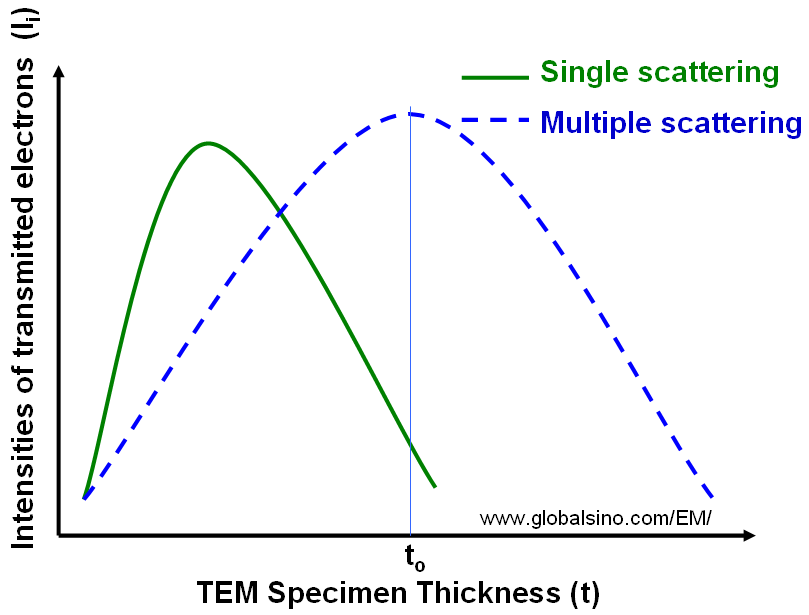=================================================================================
Figure 3503a shows the schematic illustration of the intensities of transmitted electrons originated from single and multiple
inelastic scatterings depending on the thickness of TEM specimen. For very thin specimens, the fraction of electrons, that are inelastically scattered only once in the specimen, increases in proportion to the specimen thickness. For thick specimens, the intensity of transmitted electrons originated from single inelastic scattering decrease with increasing thickness because most electrons become scattered several times. The intensity of the transmitted electrons originated from multiple inelastic scattering also decreases at thickness of t0 because the specimen is too thick and thus becomes opaque.

Figure 3503a. Schematic illustration of the intensities of transmitted electrons originated from single
and multiple
inelastic
scatterings depending on thickness of TEM specimen.
In the measurements of electron diffractions in TEM, the contribution of inelastically scattered electrons increases with decreasing atomic number and increasing foil thickness.
As we know that in TEM observation, the transmission of unscattered incident electrons is inversely proportional to the TEM specimen thickness. On the other hand, the increase of the specimen thickness enhances the energy loss of the transmitted electrons. Therefore, the spatial resolution degrades with the increase of specimen thickness because of the chromatic aberration effects. Table 3503 lists examples of the energy loss of incident electrons passing through the specimen. The use of thinner specimen can generally improve spatial resolution because it minimizes the energy loss.
Table 3503. Examples of the energy loss of electrons passing through the TEM specimen.
| |
Accelerating voltage of incident electrons |
Penetrated electrons (%) |
Penetrated electron with energy loss higher than 50 eV (%) |
Unscattered electrons (%) |
Elastically scattered electrons (%) |
| Thin metal foil |
|
50 |
40 |
|
|
| 50 nm thick carbon film |
50 kV |
|
55 |
33 |
10 |
Figure 3503b shows the experimental values of λel [1] and λin(Z) [2] as oscillatory functions of Z for Z > 20. Comparison of λel and λin values suggests that the elastic component should dominate scattering of incident high-energy electrons for most inorganic solids and of incident electrons penetrating thin TEM specimens.

Figure 3503b. The mean free path of elastic scattering λel of 200 keV electrons (solid squares) [1] and that of inelastic values λin (open circles) (Adapted from [2]).
[1] Konstantin Iakoubovskii and Kazutaka Mitsuishi, Elastic scattering of 200 keV electrons in elemental solids: experimental observation of atomic-number-dependent oscillatory behavior, J. Phys.: Condens. Matter 21 (2009) 155402.
[2] Iakoubovskii K, Mitsuishi K, Nakayama Y and Furuya K (2008) Phys. Rev. B 77, 104102.
|

